AI-Enabled Crop Management Framework for Pest Detection Using Visual Sensor Data
Abstract
1. Introduction
- We present an advanced system that uses UAVs to identify pests in real time. This groundbreaking method surpasses previous approaches with enhanced accuracy and a notable reduction in false alarms. By incorporating UAV technology, we have achieved a significant improvement in pest detection, highlighting the effectiveness of merging UAVs with this innovative solution.
- We refined the internal architecture of YOLOv5s by replacing smaller kernels in SSP (Neck) with larger ones and introducing a Stem module into the backbone. This strategic modification enhances the model’s capability to efficiently identify pests of varying sizes in images, reducing time complexity. Through extensive experimentation and comparison with nine object-detection models using a pest detection dataset, our model demonstrated empirical effectiveness and outperformed existing methods. A qualitative assessment further solidified the superior performance of our UAV-assisted pest detection technology.
2. Literature Review
3. The Proposed Methodology
3.1. The Proposed Pest Detection Model
3.2. Network Architecture
4. Experiments and Results
4.1. Experimental Setup
4.2. Dataset Selection
4.3. The Proposed Model Evaluation
4.4. Comparative Analysis with State-of-the-Art Models
4.5. Splitting Dataset Using 5-Fold Cross Validation
4.6. Model Complexity Analysis
4.7. Visual Result of the Proposed Model
4.8. Discussion
5. Conclusions
Author Contributions
Funding
Data Availability Statement
Conflicts of Interest
References
- Amiri, A.N.; Bakhsh, A. An effective pest management approach in potato to combat insect pests and herbicide. 3 Biotech 2019, 9, 16. [Google Scholar] [CrossRef]
- Fernández, R.M.; Petek, M.; Gerasymenko, I.; Juteršek, M.; Baebler, Š.; Kallam, K.; Giménez, E.M.; Gondolf, J.; Nordmann, A.; Gruden, K.; et al. Insect pest management in the age of synthetic biology. Plant Biotechnol. J. 2022, 20, 25–36. [Google Scholar] [CrossRef]
- Habib, S.; Khan, I.; Aladhadh, S.; Islam, M.; Khan, S. External Features-Based Approach to Date Grading and Analysis with Image Processing. Emerg. Sci. J. 2022, 6, 694–704. [Google Scholar] [CrossRef]
- Zhou, J.; Li, J.; Wang, C.; Wu, H.; Zhao, C.; Teng, G. Crop disease identification and interpretation method based on multimodal deep learning. Comput. Electron. Agric. 2021, 189, 106408. [Google Scholar] [CrossRef]
- Khan, H.; Haq, I.U.; Munsif, M.; Mustaqeem; Khan, S.U.; Lee, M.Y. Automated Wheat Diseases Classification Framework Using Advanced Machine Learning Technique. Agriculture 2022, 12, 1226. [Google Scholar] [CrossRef]
- Aladhadh, S.; Habib, S.; Islam, M.; Aloraini, M.; Aladhadh, M.; Al-Rawashdeh, H.S. An Efficient Pest Detection Framework with a Medium-Scale Benchmark to Increase the Agricultural Productivity. Sensors 2022, 22, 9749. [Google Scholar] [CrossRef]
- Al Hiary, H.; Ahmad, S.B.; Reyalat, M.; Braik, M.; Alrahamneh, Z. Fast and accurate detection and classification of plant diseases. Int. J. Comput. Appl. 2011, 17, 31–38. [Google Scholar] [CrossRef]
- Nguyen, T.N.; Lee, S.; Nguyen-Xuan, H.; Lee, J. A novel analysis-prediction approach for geometrically nonlinear problems using group method of data handling. Comput. Methods Appl. Mech. Eng. 2019, 354, 506–526. [Google Scholar] [CrossRef]
- Faithpraise, F.; Birch, P.; Young, R.; Obu, J.; Faithpraise, B.; Chatwin, C. Automatic plant pest detection and recognition using k-means clustering algorithm and correspondence filters. Int. J. Adv. Biotechnol. Res. 2013, 4, 189–199. [Google Scholar]
- Rumpf, T.; Mahlein, A.-K.; Steiner, U.; Oerke, E.-C.; Dehne, H.-W.; Plümer, L. Early detection and classification of plant diseases with support vector machines based on hyperspectral reflectance. Comput. Electron. Agric. 2010, 74, 91–99. [Google Scholar] [CrossRef]
- Nguyen, T.N.; Nguyen-Xuan, H.; Lee, J. A novel data-driven nonlinear solver for solid mechanics using time series forecasting. Finite Elem. Anal. Des. 2020, 171, 103377. [Google Scholar] [CrossRef]
- Shijie, J.; Peiyi, J.; Siping, H. Automatic detection of tomato diseases and pests based on leaf images. In Proceedings of the 2017 Chinese Automation Congress (CAC), Jinan, China, 20–22 October 2017. [Google Scholar]
- Gandhi, R.; Nimbalkar, S.; Yelamanchili, N.; Ponkshe, S. Plant disease detection using CNNs and GANs as an augmentative approach. In Proceedings of the 2018 IEEE International Conference on Innovative Research and Development (ICIRD), Bangkok, Thailand, 11–12 May 2018. [Google Scholar]
- Leonardo, M.M.; Carvalho, T.J.; Rezende, E.; Zucchi, R.; Faria, F.A. Deep feature-based classifiers for fruit fly identification (Diptera: Tephritidae). In Proceedings of the 2018 31st SIBGRAPI Conference on Graphics, Patterns and Images (SIBGRAPI), Parana, Brazil, 29 October–1 November 2018. [Google Scholar]
- Dawei, W.; Limiao, D.; Jiangong, N.; Jiyue, G.; Hongfei, Z.; Zhongzhi, H. Recognition pest by image-based transfer learning. J. Sci. Food Agric. 2019, 99, 4524–4531. [Google Scholar] [CrossRef] [PubMed]
- Cheeti, S.; Kumar, G.S.; Priyanka, J.S.; Firdous, G.; Ranjeeva, P.R. Pest detection and classification using YOLO AND CNN. Ann. Rom. Soc. Cell Biol. 2021, 15295–15300. [Google Scholar]
- Mique, E.L., Jr.; Palaoag, T.D. Rice pest and disease detection using convolutional neural network. In Proceedings of the 1st International Conference on Information Science and Systems, Jeju, Republic of Korea, 27–29 April 2018. [Google Scholar] [CrossRef]
- Nam, N.T.; Hung, P.D. Pest detection on traps using deep convolutional neural networks. In Proceedings of the 1st International Conference on Control and Computer Vision, Singapore, 15–18 June 2018. [Google Scholar]
- Burhan, S.A.; Minhas, S.; Tariq, A.; Hassan, M.N. Comparative study of deep learning algorithms for disease and pest detection in rice crops. In Proceedings of the 2020 12th International Conference on Electronics, Computers and Artificial Intelligence (ECAI), Bucharest, Romania, 25–27 June 2020. [Google Scholar]
- Koubaa, A.; Aldawood, A.; Saeed, B.; Hadid, A.; Ahmed, M.; Saad, A.; Alkhouja, H.; Ammar, A.; Alkanhal, M. Smart Palm: An IoT framework for red palm weevil early detection. Agronomy 2020, 10, 987. [Google Scholar] [CrossRef]
- Habib, S.; Khan, I.; Islam, M.; Albattah, W.; Alyahya, S.M.; Khan, S.; Hassan, M.K. Wavelet frequency transformation for specific weeds recognition. In Proceedings of the 2021 1st International Conference on Artificial Intelligence and Data Analytics (CAIDA), Riyadh, Saudi Arabia, 6–7 April 2021. [Google Scholar]
- Esgario, J.G.; de Castro, P.B.; Tassis, L.M.; Krohling, R.A. An app to assist farmers in the identification of diseases and pests of coffee leaves using deep learning. Inf. Process. Agric. 2022, 9, 38–47. [Google Scholar] [CrossRef]
- Hansen, O.L.P.; Svenning, J.; Olsen, K.; Dupont, S.; Garner, B.H.; Iosifidis, A.; Price, B.W.; Høye, T.T. Species-level image classification with convolutional neural network enables insect identification from habitus images. Ecol. Evol. 2020, 10, 737–747. [Google Scholar] [CrossRef] [PubMed]
- Ullah, N.; Khan, J.A.; Alharbi, L.A.; Raza, A.; Khan, W.; Ahmad, I. An Efficient Approach for Crops Pests Recognition and Classification Based on Novel DeepPestNet Deep Learning Model. IEEE Access 2022, 10, 73019–73032. [Google Scholar] [CrossRef]
- Li, W.; Zhu, T.; Li, X.; Dong, J.; Liu, J. Recommending advanced deep learning models for efficient insect pest detection. Agriculture 2022, 12, 1065. [Google Scholar] [CrossRef]
- Hu, Z.; Xiang, Y.; Li, Y.; Long, Z.; Liu, A.; Dai, X.; Lei, X.; Tang, Z. Research on Identification Technology of Field Pests with Protective Color Characteristics. Appl. Sci. 2022, 12, 3810. [Google Scholar] [CrossRef]
- Chen, J.-W.; Lin, W.-J.; Cheng, H.-J.; Hung, C.-L.; Lin, C.-Y.; Chen, S.-P. A smartphone-based application for scale pest detection using multiple-object detection methods. Electronics 2021, 10, 372. [Google Scholar] [CrossRef]
- Legaspi, K.R.B.; Sison, N.W.S.; Villaverde, J.F. Detection and Classification of Whiteflies and Fruit Flies Using YOLO. In Proceedings of the 2021 13th International Conference on Computer and Automation Engineering (ICCAE), Melbourne, Australia, 20–22 March 2021. [Google Scholar]
- Karar, M.E.; Alsunaydi, F.; Albusaymi, S.; Alotaibi, S. A new mobile application of agricultural pests recognition using deep learning in cloud computing system. Alex. Eng. J. 2021, 60, 4423–4432. [Google Scholar] [CrossRef]
- Alsanea, M.; Habib, S.; Khan, N.F.; Alsharekh, M.F.; Islam, M.; Khan, S. A Deep-Learning Model for Real-Time Red Palm Weevil Detection and Localization. J. Imaging 2022, 8, 170. [Google Scholar] [CrossRef]
- Liu, J.; Wang, X. Tomato diseases and pests detection based on improved Yolo V3 convolutional neural network. Front. Plant Sci. 2020, 11, 898. [Google Scholar] [CrossRef] [PubMed]
- Nguyen, T.N.; Lee, S.; Nguyen, P.-C.; Nguyen-Xuan, H.; Lee, J. Geometrically nonlinear postbuckling behavior of imperfect FG-CNTRC shells under axial compression using isogeometric analysis. Eur. J. Mech.-A/Solids 2020, 84, 104066. [Google Scholar] [CrossRef]
- Redmon, J.; Divvala, S.; Girshick, R.; Farhadi, A. You only look once: Unified, real-time object detection. In Proceedings of the IEEE Conference on Computer Vision and Pattern Recognition, Las Vegas, NV, USA, 27–30 June 2016. [Google Scholar]
- Redmon, J.; Farhadi, A. Yolov3: An incremental improvement. arXiv 2018, arXiv:1804.02767. [Google Scholar]
- Bochkovskiy, A.; Wang, C.-Y.; Liao, H.-Y.M. Yolov4: Optimal speed and accuracy of object detection. arXiv 2020, arXiv:2004.10934. [Google Scholar]
- Feng, Z.; Guo, L.; Huang, D.; Li, R. Electrical insulator defects detection method based on yolov5. In Proceedings of the 2021 IEEE 10th Data Driven Control and Learning Systems Conference (DDCLS), Suzhou, China, 14–16 May 2021. [Google Scholar]
- Dong, X.; Yan, S.; Duan, C. A lightweight vehicles detection network model based on YOLOv5. Eng. Appl. Artif. Intell. 2022, 113, 104914. [Google Scholar] [CrossRef]
- Elfwing, S.; Uchibe, E.; Doya, K. Sigmoid-weighted linear units for neural network function approximation in reinforcement learning. Neural Netw. 2018, 107, 3–11. [Google Scholar] [CrossRef]
- Hu, W.; Xiong, J.; Liang, J.; Xie, Z.; Liu, Z.; Huang, Q.; Yang, Z. A method of citrus epidermis defects detection based on an improved YOLOv5. Biosyst. Eng. 2023, 227, 19–35. [Google Scholar] [CrossRef]
- Li, D.; Ahmed, F.; Wu, N.; Sethi, A.I. Yolo-JD: A Deep Learning Network for jute diseases and pests detection from images. Plants 2022, 11, 937. [Google Scholar] [CrossRef]
- Ali, F.; Qayyum, H.; Iqbal, M.J. Faster-PestNet: A Lightweight deep learning framework for crop pest detection and classification. IEEE Access 2023, 11, 104016–104027. [Google Scholar] [CrossRef]
- Hua, S.; Xu, M.; Xu, Z.; Ye, H.; Zhou, C. Multi-feature decision fusion algorithm for disease detection on crop surface based on machine vision. Neural Comput. Appl. 2022, 34, 9471–9484. [Google Scholar] [CrossRef]
- Tang, Z.; Lu, J.; Chen, Z.; Qi, F.; Zhang, L. Improved Pest-YOLO: Real-time pest detection based on efficient channel attention mechanism and transformer encoder. Ecol. Inform. 2023, 78, 102340. [Google Scholar] [CrossRef]
- Dong, Q.; Sun, L.; Han, T.; Cai, M.; Gao, C. PestLite: A Novel YOLO-Based Deep Learning Technique for Crop Pest Detection. Agriculture 2024, 14, 228. [Google Scholar] [CrossRef]
- Jiao, L.; Dong, S.; Zhang, S.; Xie, C.; Wang, H. AF-RCNN: An anchor-free convolutional neural network for multi-categories agricultural pest detection. Comput. Electron. Agric. 2020, 174, 105522. [Google Scholar] [CrossRef]
- Wang, Q.-J.; Zhang, S.-Y.; Dong, S.-F.; Zhang, G.-C.; Yang, J.; Li, R.; Wang, H.-Q. Pest24: A large-scale very small object data set of agricultural pests for multi-target detection. Comput. Electron. Agric. 2020, 175, 105585. [Google Scholar] [CrossRef]
- Zhang, W.; Huang, H.; Sun, Y.; Wu, X. AgriPest-YOLO: A rapid light-trap agricultural pest detection method based on deep learning. Front. Plant Sci. 2022, 13, 1079384. [Google Scholar] [CrossRef]
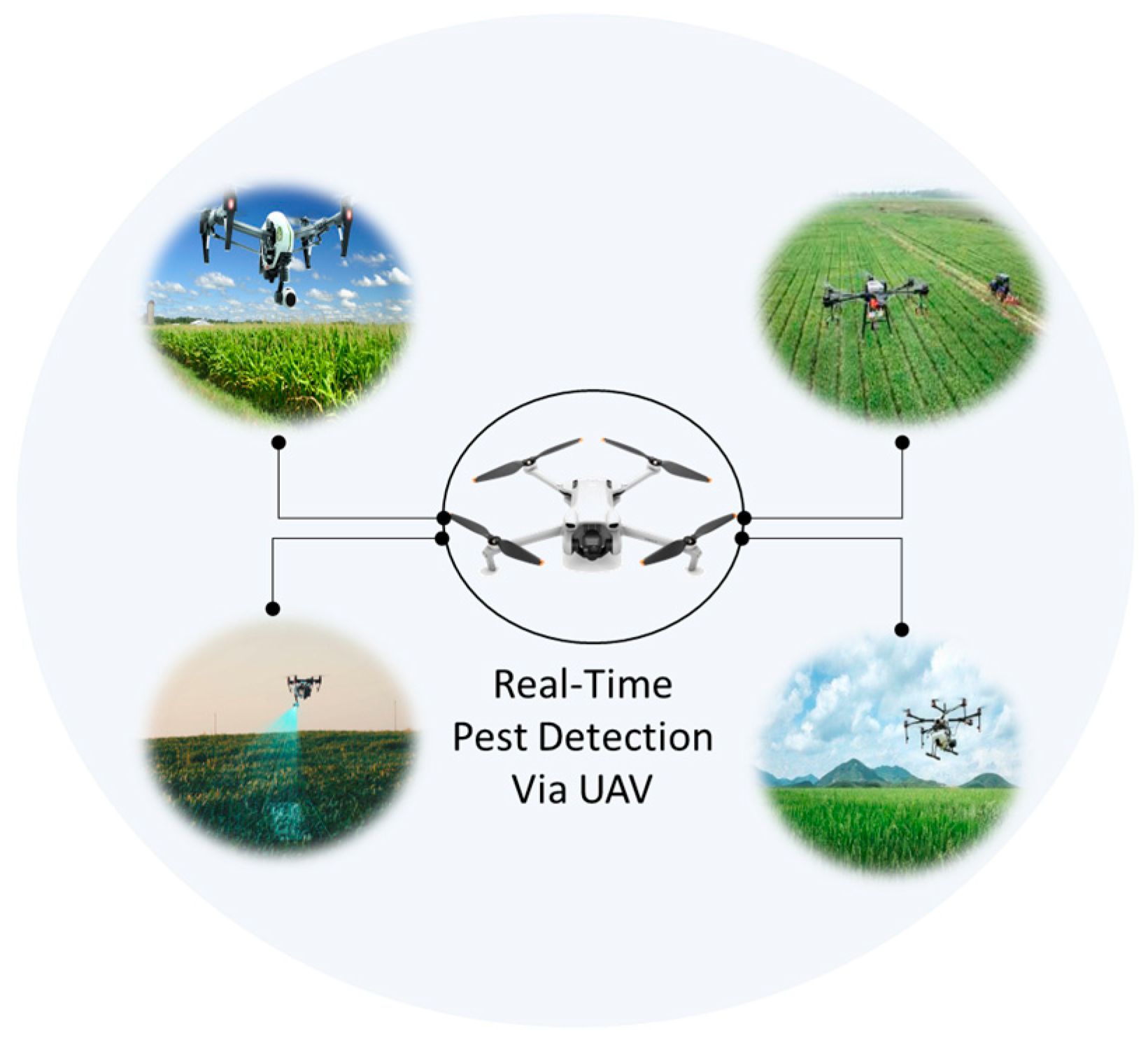
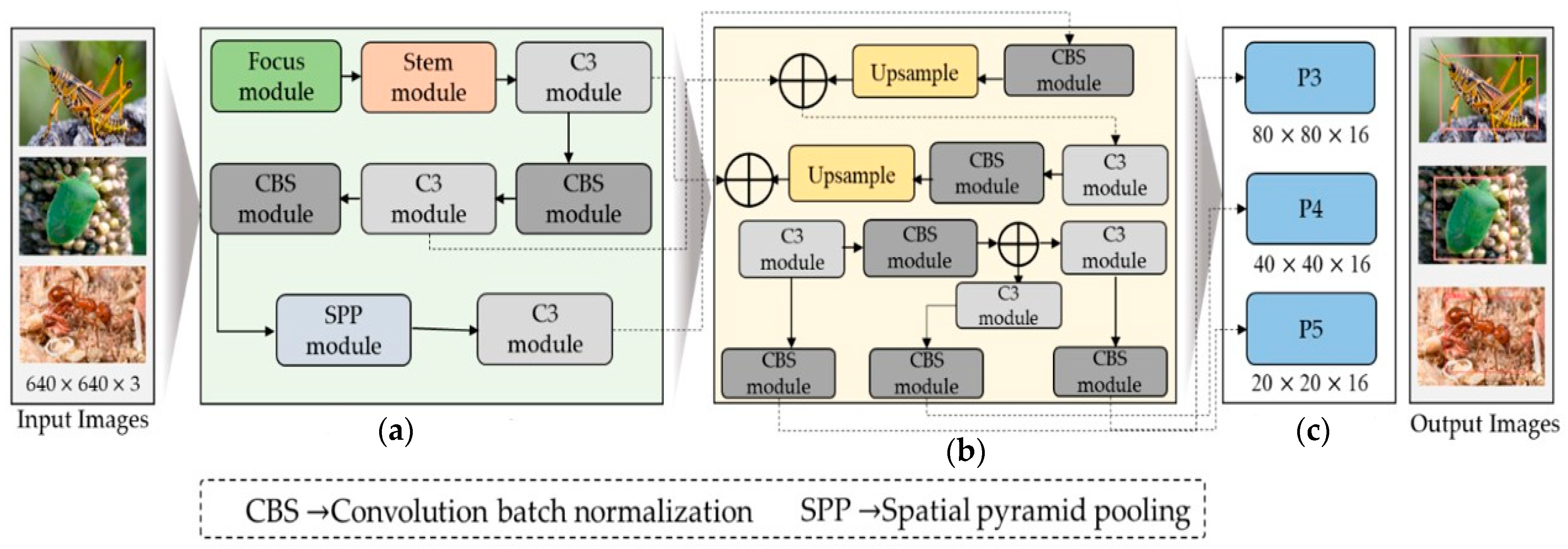

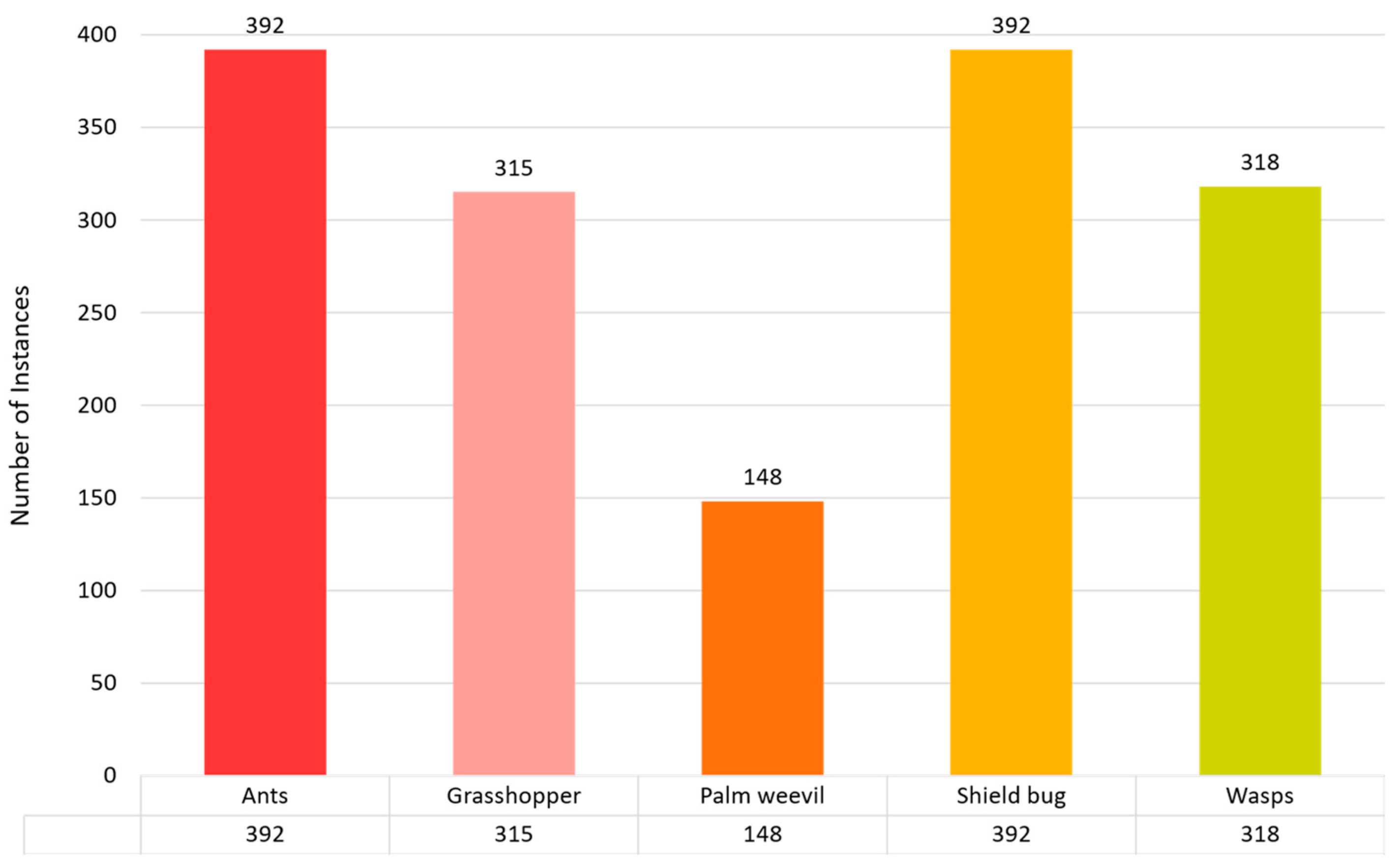
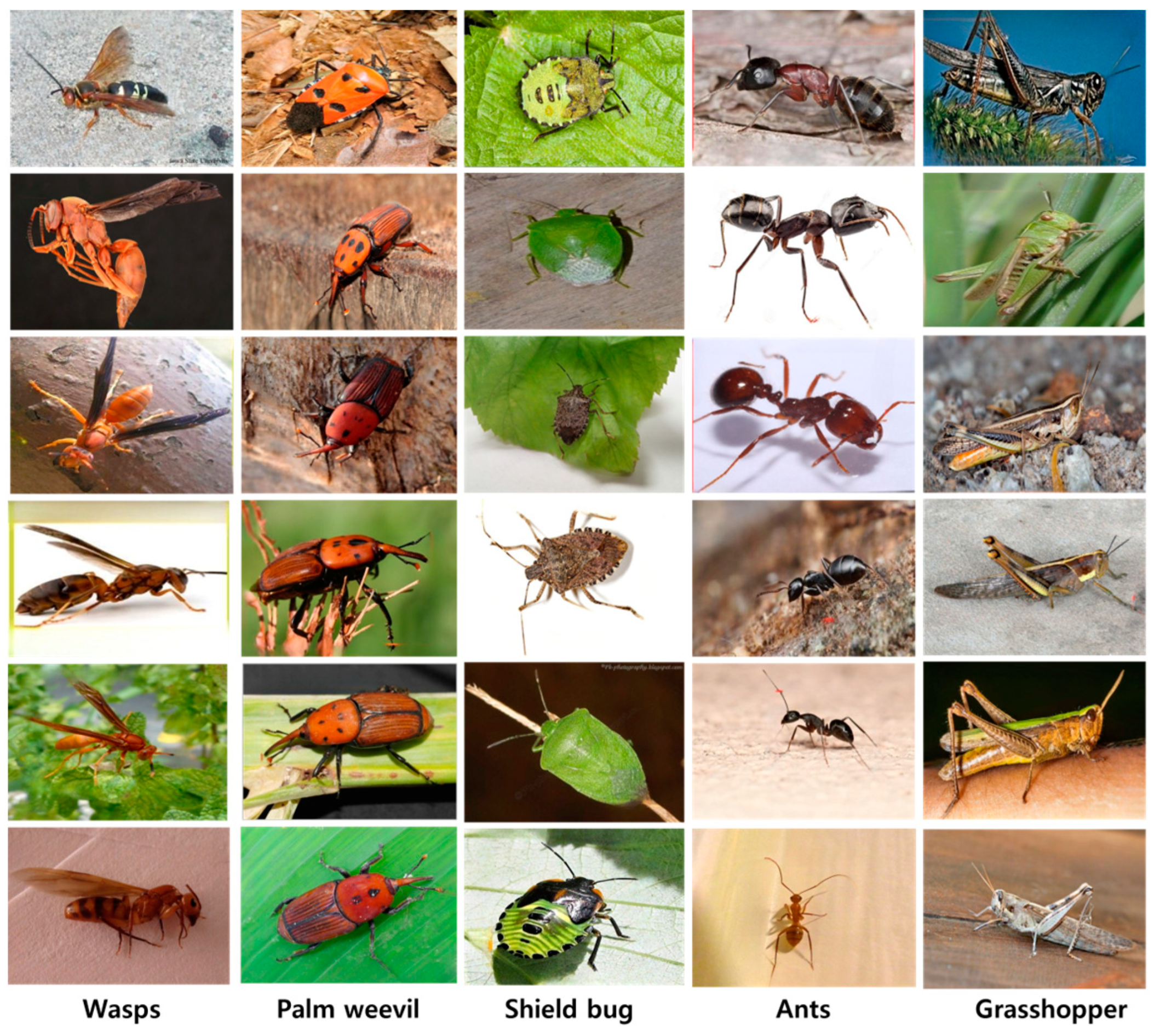
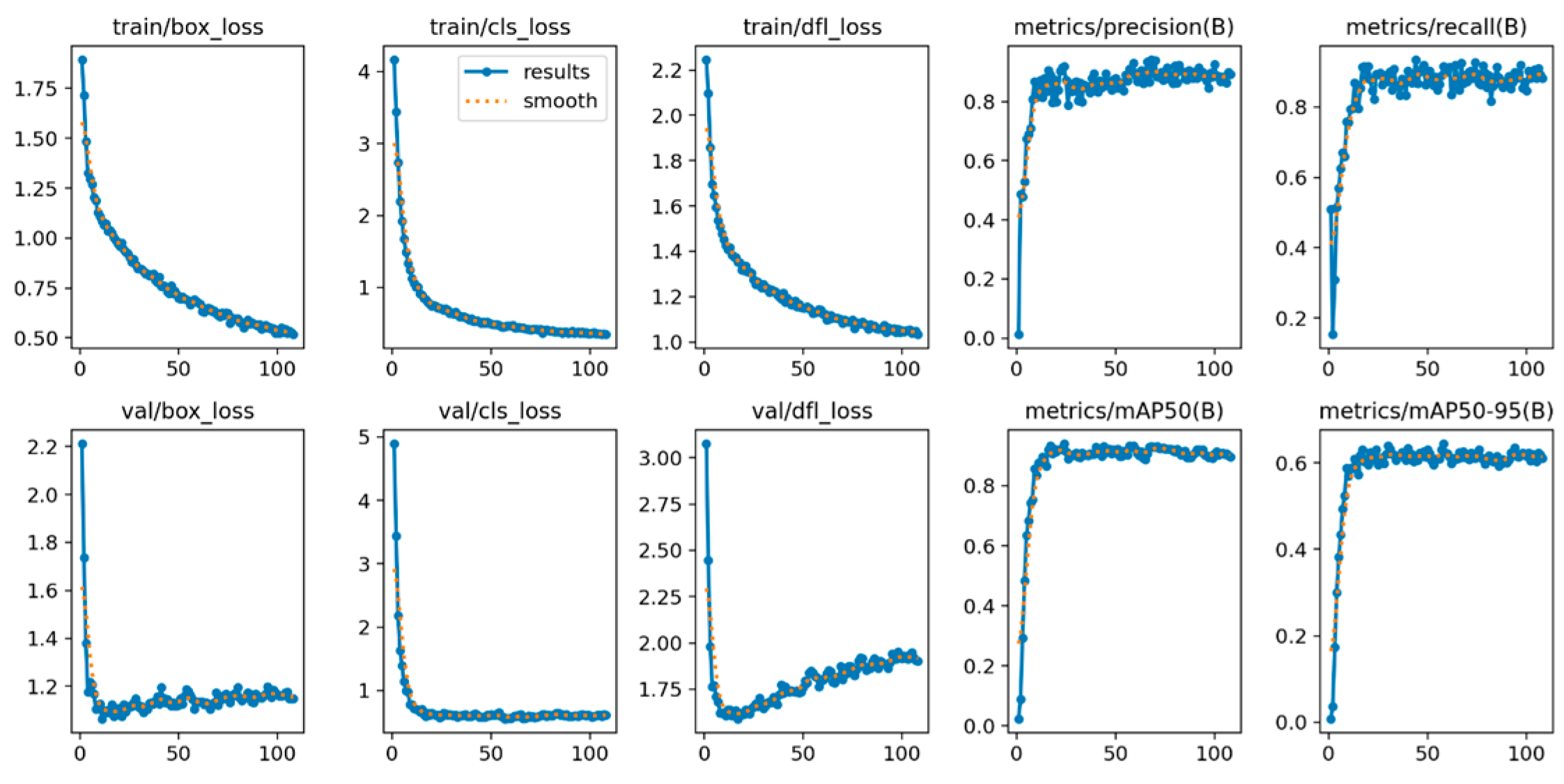
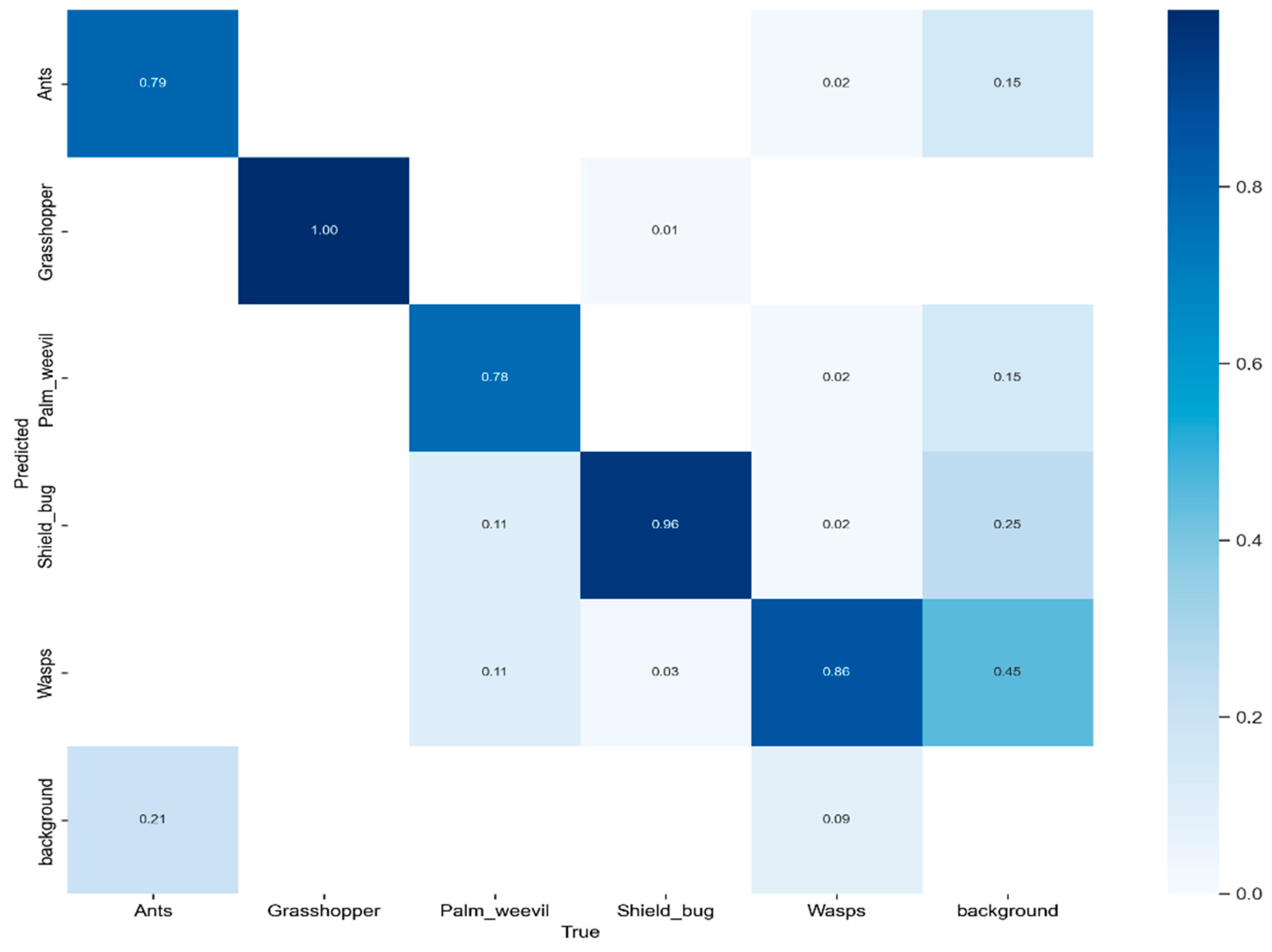
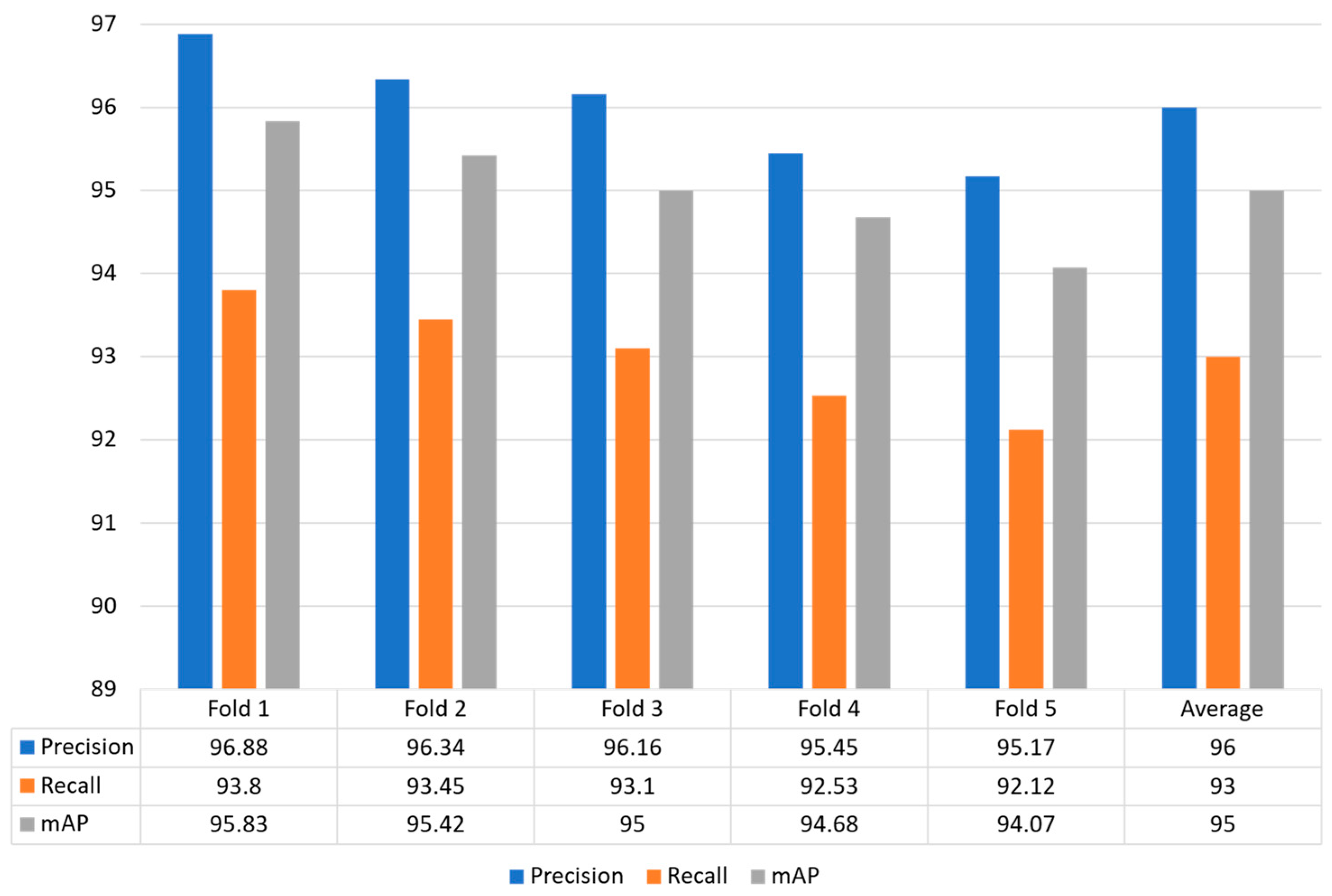
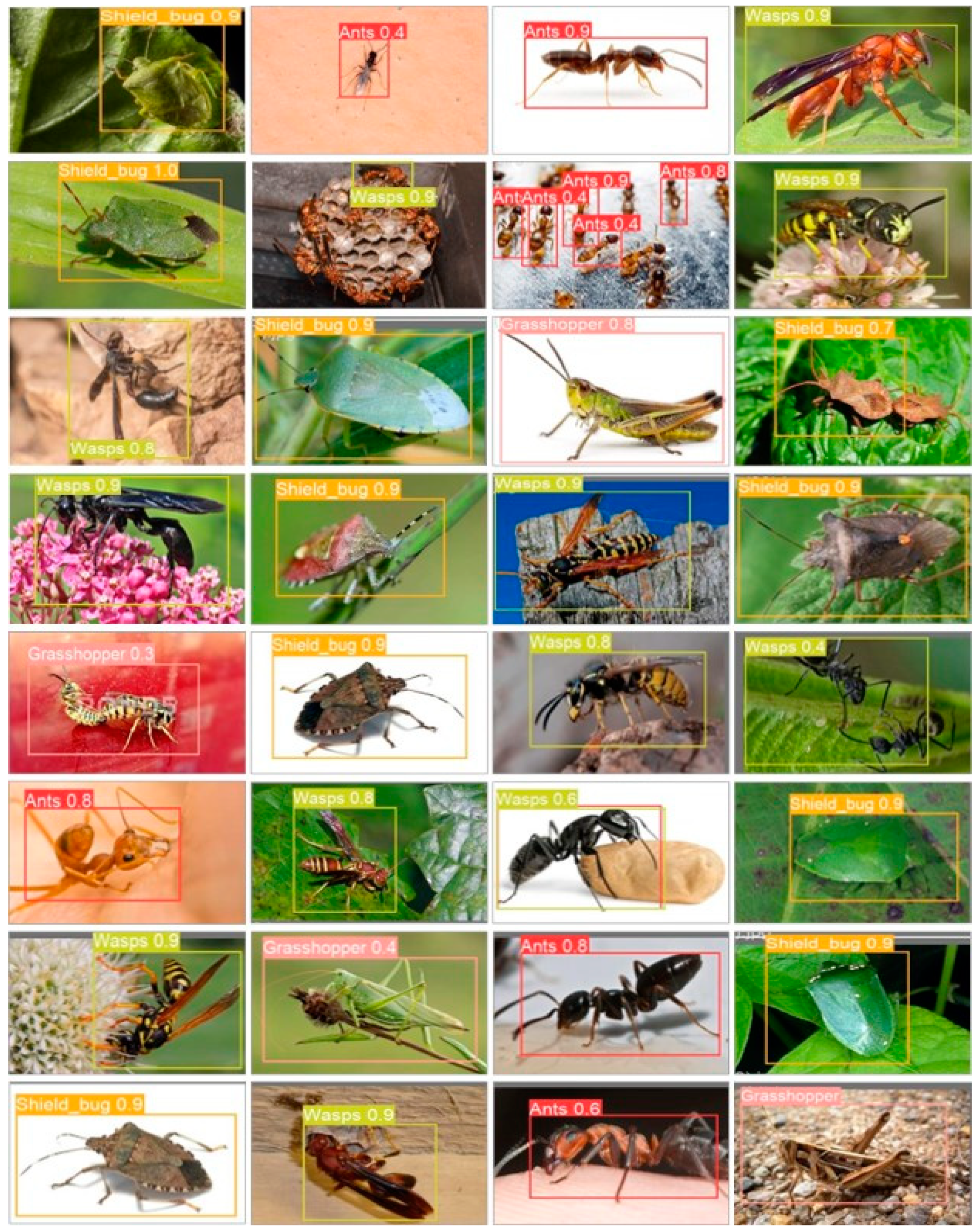
| Models | Classes | Precision | Recall | mAP |
|---|---|---|---|---|
| Faster-RCNN | Ants | 0.73 | 0.74 | 0.76 |
| Grasshopper | 0.98 | 0.99 | 1.00 | |
| Palm_weevil | 0.99 | 0.88 | 0.98 | |
| Shield_bug | 0.96 | 0.97 | 1.00 | |
| Wasp | 0.94 | 0.86 | 0.91 | |
| Average | 0.92 | 0.89 | 0.92 | |
| YoloV3 | Ants | 0.59 | 0.75 | 0.64 |
| Grasshopper | 0.86 | 0.84 | 0.91 | |
| Palm_weevil | 0.91 | 0.93 | 0.95 | |
| Shield_bug | 0.88 | 0.91 | 0.93 | |
| Wasp | 0.87 | 0.9 | 0.88 | |
| Average | 0.82 | 0.87 | 0.86 | |
| YoloV4 | Ants | 0.65 | 0.76 | 0.71 |
| Grasshopper | 0.87 | 0.83 | 0.93 | |
| Palm_weevil | 0.93 | 0.92 | 0.96 | |
| Shield_bug | 0.9 | 0.94 | 0.95 | |
| Wasp | 0.88 | 0.91 | 0.89 | |
| Average | 0.85 | 0.87 | 0.89 | |
| YOLOv5n | Ants | 0.57 | 0.74 | 0.68 |
| Grasshopper | 0.92 | 0.87 | 0.94 | |
| Palm_weevil | 1.00 | 0.98 | 0.99 | |
| Shield_bug | 0.93 | 0.97 | 0.98 | |
| Wasp | 0.92 | 0.82 | 0.87 | |
| Average | 0.87 | 0.88 | 0.89 | |
| YOLOv5s | Ants | 0.80 | 0.68 | 0.78 |
| Grasshopper | 0.90 | 0.87 | 0.88 | |
| Palm_weevil | 0.96 | 1.00 | 0.99 | |
| Shield_bug | 0.97 | 0.91 | 0.98 | |
| Wasp | 0.89 | 0.71 | 0.87 | |
| Average | 0.91 | 0.83 | 0.90 | |
| YOLOv5m | Ants | 0.86 | 0.65 | 0.73 |
| Grasshopper | 0.95 | 1.00 | 0.99 | |
| Palm_weevil | 1.00 | 0.82 | 0.99 | |
| Shield_bug | 0.94 | 0.93 | 0.97 | |
| Wasp | 0.93 | 0.82 | 0.84 | |
| Average | 0.94 | 0.84 | 0.91 | |
| YOLOv5l | Ants | 0.72 | 0.72 | 0.98 |
| Grasshopper | 1.00 | 0.93 | 0.99 | |
| Palm_weevil | 0.76 | 1.00 | 0.98 | |
| Shield_bug | 0.89 | 0.96 | 0.96 | |
| Wasp | 0.88 | 0.84 | 0.89 | |
| Average | 0.85 | 0.89 | 0.92 | |
| YOLOv5x | Ants | 0.70 | 0.72 | 0.76 |
| Grasshopper | 0.97 | 1.00 | 0.99 | |
| Palm_weevil | 1.00 | 0.87 | 0.97 | |
| Shield_bug | 0.97 | 0.98 | 0.99 | |
| Wasp | 0.92 | 0.84 | 0.89 | |
| Average | 0.91 | 0.88 | 0.92 | |
| EPD | Ants | 0.79 | 0.76 | 0.80 |
| Grasshopper | 0.98 | 1.00 | 0.99 | |
| Palm_weevil | 1.00 | 0.89 | 0.98 | |
| Shield_bug | 0.97 | 0.98 | 0.99 | |
| Wasp | 0.94 | 0.86 | 0.90 | |
| Average | 0.94 | 0.90 | 0.93 | |
| Our model | Ants | 0.86 | 0.83 | 0.84 |
| Grasshopper | 0.99 | 1.00 | 0.99 | |
| Palm_weevil | 1.00 | 0.94 | 0.99 | |
| Shield_bug | 0.99 | 0.98 | 0.99 | |
| Wasp | 0.96 | 0.89 | 0.94 | |
| Average | 0.96 | 0.93 | 0.95 |
| Model | Model Size | GFLOPs | FPS (CPU) |
|---|---|---|---|
| YOLOv5n | 3.65 | 4.20 | 31.02 |
| YOLOv5s | 14.1 | 16.00 | 21.25 |
| YOLOv5m | 40.2 | 48.30 | 10.16 |
| YOLOv5l | 88.5 | 108.30 | 6.62 |
| YOLOv5x | 165 | 204.70 | 3.90 |
| Our model | 14.0 | 15.00 | 22.75 |
Disclaimer/Publisher’s Note: The statements, opinions and data contained in all publications are solely those of the individual author(s) and contributor(s) and not of MDPI and/or the editor(s). MDPI and/or the editor(s) disclaim responsibility for any injury to people or property resulting from any ideas, methods, instructions or products referred to in the content. |
© 2024 by the authors. Licensee MDPI, Basel, Switzerland. This article is an open access article distributed under the terms and conditions of the Creative Commons Attribution (CC BY) license (https://creativecommons.org/licenses/by/4.0/).
Share and Cite
Khan, A.; Malebary, S.J.; Dang, L.M.; Binzagr, F.; Song, H.-K.; Moon, H. AI-Enabled Crop Management Framework for Pest Detection Using Visual Sensor Data. Plants 2024, 13, 653. https://doi.org/10.3390/plants13050653
Khan A, Malebary SJ, Dang LM, Binzagr F, Song H-K, Moon H. AI-Enabled Crop Management Framework for Pest Detection Using Visual Sensor Data. Plants. 2024; 13(5):653. https://doi.org/10.3390/plants13050653
Chicago/Turabian StyleKhan, Asma, Sharaf J. Malebary, L. Minh Dang, Faisal Binzagr, Hyoung-Kyu Song, and Hyeonjoon Moon. 2024. "AI-Enabled Crop Management Framework for Pest Detection Using Visual Sensor Data" Plants 13, no. 5: 653. https://doi.org/10.3390/plants13050653
APA StyleKhan, A., Malebary, S. J., Dang, L. M., Binzagr, F., Song, H.-K., & Moon, H. (2024). AI-Enabled Crop Management Framework for Pest Detection Using Visual Sensor Data. Plants, 13(5), 653. https://doi.org/10.3390/plants13050653








